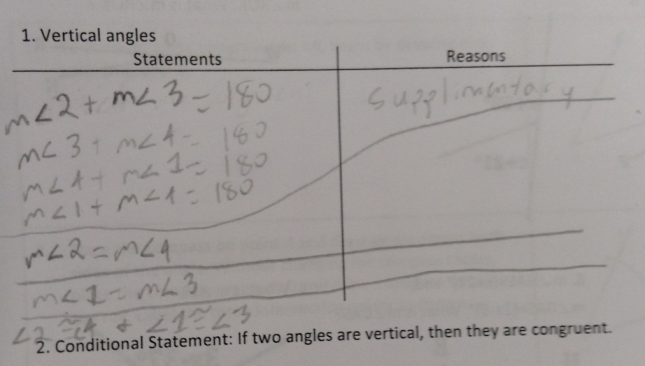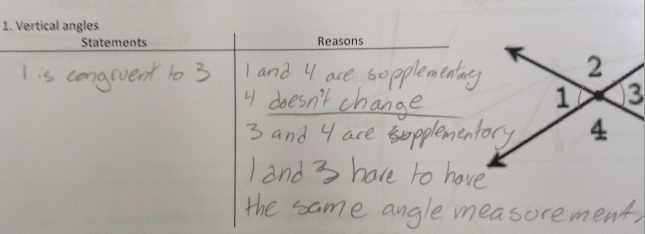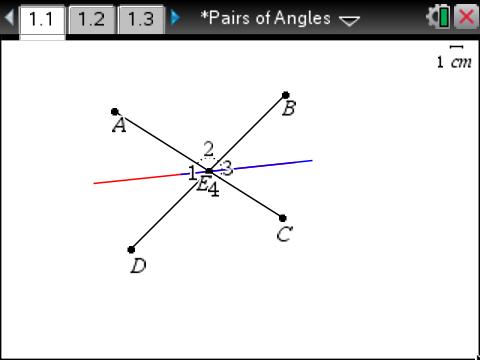CCSS-M.G-CO.C.9. Prove theorems about lines and angles. Theorems include: vertical angles are congruent; when a transversal crosses parallel lines, alternate interior angles are congruent and corresponding angles are congruent; points on a perpendicular bisector of a line segment are exactly those equidistant from the segment’s endpoints.
How do we know that vertical angles are congruent, other than “my teacher told me”, or “the dynamic geometry software convinces me”. (Even though we did let our dynamic geometry software convince us, as most students had not before seen measured vertical angles move.)
Students worked individually first. I monitored their work.
How many times have you heard a student say that they don’t know where to start when writing a proof?
Can the leveled learning progression that Jill Gough (@jgough) and I have written for construct a viable argument and critique the reasoning of others help?
What information is given (or implied) in the diagram?
One student marked given information on the diagram so that she could understand it.
Another student is on her way to establishing given information and is working on communicating why her conjecture must be true.
Another student uses his given information and can get to m∠2=m∠4 but should probably show that m∠2+m∠3=m∠3+m∠4 more directly.

Without realizing it, another student is on her way to establishing the Congruent Supplements Theorem. We can see from her work that she used some angle measures to make sense of why vertical angles have to be congruent.
And another student with a “congruent supplements” argument but not written exactly the same way.
So 1 of the 31 students suggested that vertical angles are congruent because of a reflection.
What information do we need to know to define a reflection?
An object and a line.
So about what line are you reflecting ∠2 or ∠4 to show that the figures are congruent?
By the time I had made it around the room again, TL had decided that the angles should be reflected about the angle bisector of ∠3 and ∠1.
When we were ready for the whole class discussion, we started with the progression of traditional Euclidean proofs – letting each student I called on adding a bit more to the argument. Then we considered TL’s proof with rigid motions.
His argument makes sense to the class – and in fact if we test the conjecture using technology we can see that it is true:
But I wonder how we can prove the angle bisector of ∠1 is collinear with the angle bisector of ∠3 without technology. Maybe an indirect proof would work?
So is there another rigid motion that would let us show the congruence of vertical angles?
A rotation?
A rotation of what object about what point using how many degrees?
And so, together, we came up with the following argument to show that vertical angles are congruent using a rotation.
And so the journey continues … learning more about transformational geometry every day from my students, who see geometry unfold differently than I, because their study of geometry started with rigid motions.












howardat58
November 18, 2014 at 12:43 pm
It’s more convincing if you rotate the whole two line figure 180 around the X. Then each line ends up on top of itself, but the angles swapped places.
i think Euclid defined “Angle” as the “space” between two lines, in which case there is nothing to prove about vertical angles.
jwilson828
November 19, 2014 at 6:01 am
I like the idea of rotating the whole angle, and I agree that it is more convincing. Thank you!
howardat58
November 18, 2014 at 1:07 pm
Even simpler is to rotate one of the lines around the X by the measure of the upper vertical angle. It now lies on top of the other line, and the lower part has swept out the same angle as the upper part. but that’s the lower vertical angle. Done !
howardat58
November 18, 2014 at 1:09 pm
Or one could use a proof by contradiction: Assume that the vertical angles are not equal. It doesn’t take long to figure out that at least one of the lines has a kink in it.
mrdardy
November 19, 2014 at 1:05 pm
Jennifer
Some lovely work here by the students – thanks for sharing! One question on my mind as I wander through Geometry with my cherubs. Are you strictly working within a two column proof format at this point? I know that I am biased because of the way MY brain works, but it feels to me that the paragraph proof format works more naturally for some of my kiddos.
jwilson828
November 19, 2014 at 2:08 pm
So this was actually one of their first experiences with the two column proof. Our previous work had been more paragraph-ish explaining why. We were just beginning to create more formal arguments – this is the first theorem that we formally prove. Your question makes me think I should consider taking off the “statements/reasons” template, though, because I really don’t care how they present their argument, and the template might inhibit some students from starting. Thank you for asking!